Pyromania Doesn’t Exist
Pyromania Doesn’t Exist
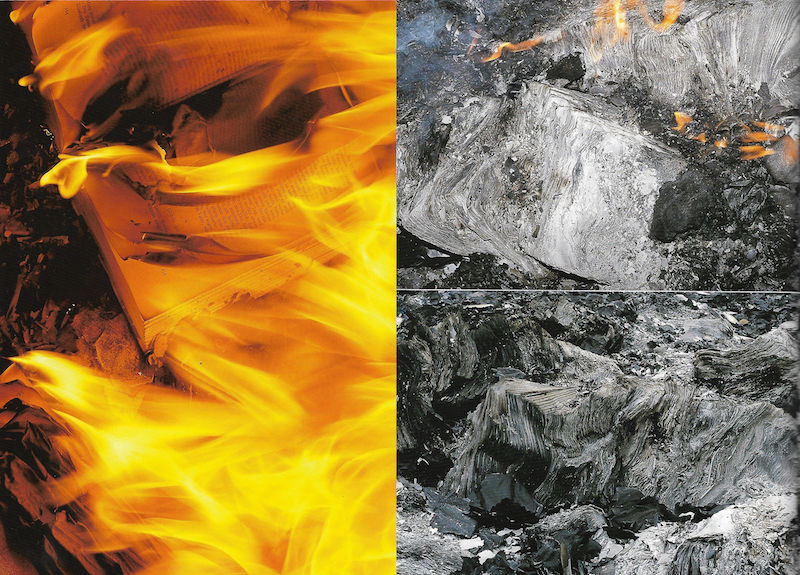
Elvia Wilk: The outcome of Bücherfeuer was in fact a book, where you published images of the performance and fragments of burned paper. Was there an intentional irony in printing a book as a record of book-burning?
Kain Karawahn: That was the intention: to recycle the knowledge. Our final aim was to make a book about the project, which was published in 1999.
Will you ever destroy your own book?
Of course, it will destroy itself anyway. Over 400 years, the chemical substances in the ink will destroy the paper.
Unless it gets mummified.
Or digitized.
Maybe that’s a form of mummification. Are you interested in making things that will last, or mainly in the act of destruction?
Burning is the source of being. It started with the big bang, which slowly burned. Fire created the universe, and what we have inside all of us is this same transformation of energy. The sun is burning, this planet is burning inside, and you, as a biological being, are burning. It’s the battery of fire. You must burn, because you store energy, which will reach a critical point when it needs to burn to reach a balance. It’s a search to create harmony.
Are there things you haven’t been able to burn?
Everything can be consumed. That’s a thermodynamic principle. Even when something burns it’s not lost; it’s transformed. A few years after Bücherfeuer, I read a very interesting statement by quantum physicists, who have agreed that no information can get lost in the universe. As a metaphor, they said that if you were to throw a book in a fireplace, of course it will burn—you can’t read it—but the information in the book can’t get lost.
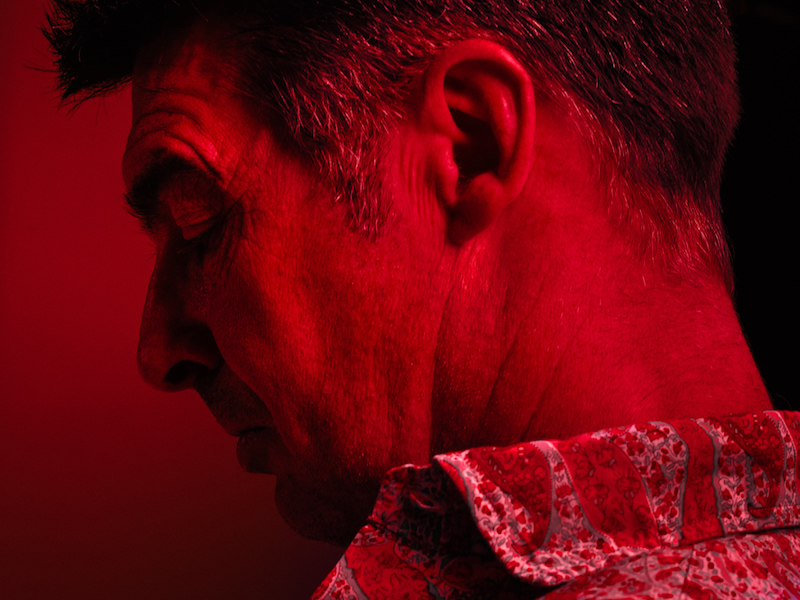
When did your interest in fire “consume" you?
I became aware that this could be a medium fit for my artistic interest in 1983. I started with photography. I’m an autodidact—I didn’t study art, I grew up without any artistic context in a little town close to Braunschweig. I was interested in setting up scenes [to photograph]. I had this idea to burn roses, but I had no idea how to set flowers on fire, so I went to the store and bought all these chemicals with flammable signs. I managed to set them on fire, and the images that came out looked good, so I made a performance from the process.
In 1984 I came to Berlin, when it was still West and East. When I saw the Berlin Wall, I thought it would make a very strong image to set it on fire. So I found some collaborators, and we went up to the the west side of the wall at Potsdamer Platz and set it on fire with gasoline.
You weren’t worried about getting arrested?
The police couldn’t see us. We hid behind the wall. It was fast. The video we made is one minute long. It’s very famous. Then we went to other places in Berlin and did the same thing, without any announcement. We did one performance near the Gropius Bau, where there were tram tracks leading through the wall. We filled them with gasoline and set them on fire. The statement we wanted to make was not that we should burn down the wall; the statement was one of freedom. Fire means freedom. West Berlin was an island surrounded by the wall; normally, an island is surrounded by water and you’re able to leave on your own. But to leave West Berlin, you depended on the legal exit procedure. You couldn’t climb over without getting shot.

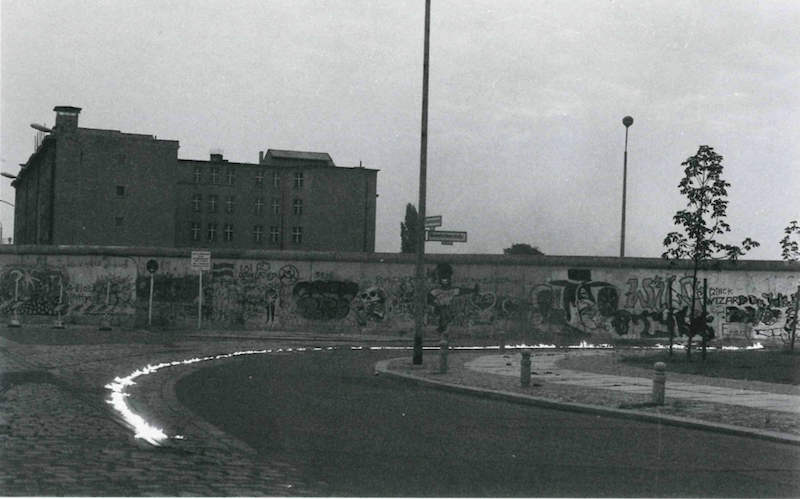
So you made a moat of fire instead of water.
The intention wasn’t to hurt anybody. We wanted to leave it as it was before, just to take these virtual images and video and leave. It was a success. You can see in the video that the fire makes a wave, leading up to the wall. I did other performances in Berlin, making video and photography without asking. This became more and more successful. I realized it was possible to make my living out of this theme: man and fire. So I went very deep into the relation between man and fire and made theater and audio plays and so on.
But you aren’t working this way anymore, are you?
Thirteen years ago, I started to work with children. In western society, there is no way for three, four, or five-year-old children to learn to make fire by themselves. It’s forbidden. So I invented a learning model that works very well for them. I teach kids how to cook with fire, make matchboxes, do everything by themselves. In March there was an article in the New York Times on this project, because it’s unique worldwide.
Why did you start doing this?
I became very successful as an artist in the 1990s and early 2000s, but I became less satisfied. I had big audiences and budgets, many people worked for me, but I was not as close to my own work as I had been in the beginning. [At a certain point] you realize what you have to do to stay successful—and I realized that I would have to repeat myself. To make my living from art, I had to become more and more art-market compatible. This meant that my content wasn’t foregrounded; it was my value, my brand, my name.
So I stopped in 2002 and I took a break. Then I got involved with pedagogy and developed this teaching model. I do this still as an artist, but now I can have an influence in society. I’m not in galleries or museums now; I work with people who I wouldn’t have met otherwise. And I improve the world, I make it a little bit better, which was my intention when I started to be an artist. The work I do now is very satisfying and I’ve also been awarded in the arts for it.
So it’s still supported via the arts?
Insurance companies and others pay me to teach. And I’ve done seminars for educators to spread my model.
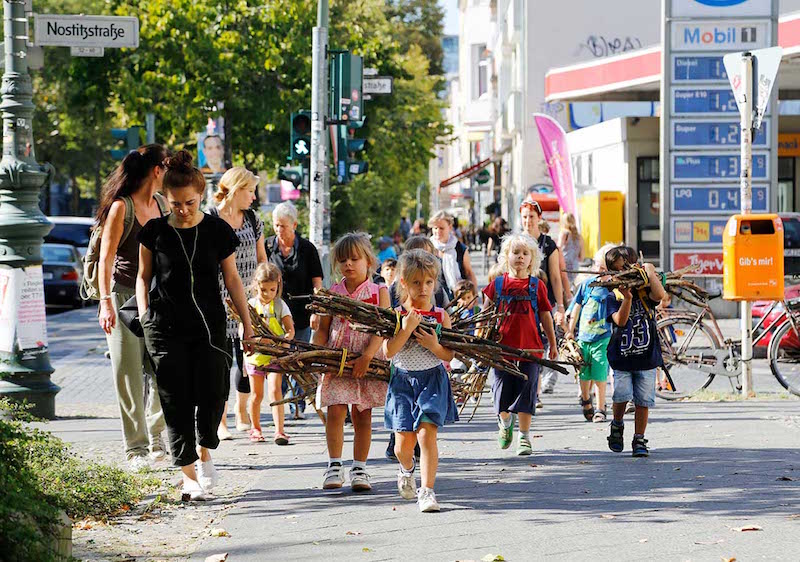
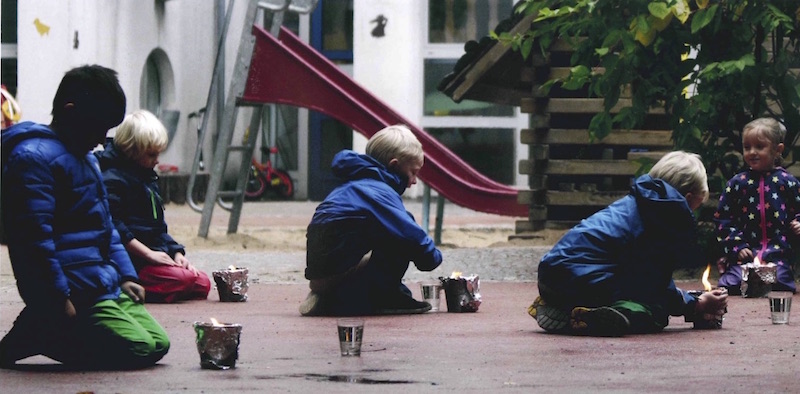
Insurance companies pay because they want to lower the risk of children starting fires?
That’s one thing. The other is that there are more and more accidents involving people between 20 and 30 years old, at a higher rate than ever before. For the last 20 or 30 years, childhood has been made very secure. You have these “helicopter parents” and in kindergarten, in school, everything is safe. Kids aren’t allowed to play with dirt or climb trees or to cut with sharp knives.
If you haven’t learned to make fire by yourself responsibly when you’re young, you’ll compensate for it when you’re a teenager. Teenagers start copying YouTube videos or movie stunts with fire, but they have no idea how to control the wind, the fuel, anything. This costs a lot of money and life. Insurance companies realize that there’s no family commitment to teaching risk-competence, so there’s no way to get a gut feeling for risk in early childhood anymore. They decided that fire is the best way to learn how to be responsible. When you start a fire, you have to stay close to it; you can’t run away.
When I get offers to do performances or projects, I always say, let’s do it with children or teenagers. I have a lot of enemies who say I’m crazy to do this, but it’s a movement and it’s beginning.
Have you ever had an accident?
Of course, I’ve been burned, but fire is controllable. It’s inside of us. When I work with three-year-olds, I can’t teach them how to make fire; I offer them a situation, and it comes out of them. The main problem in our society is that parents don’t have time to observe what their kids are really doing. They just tell children to stop, keep away.
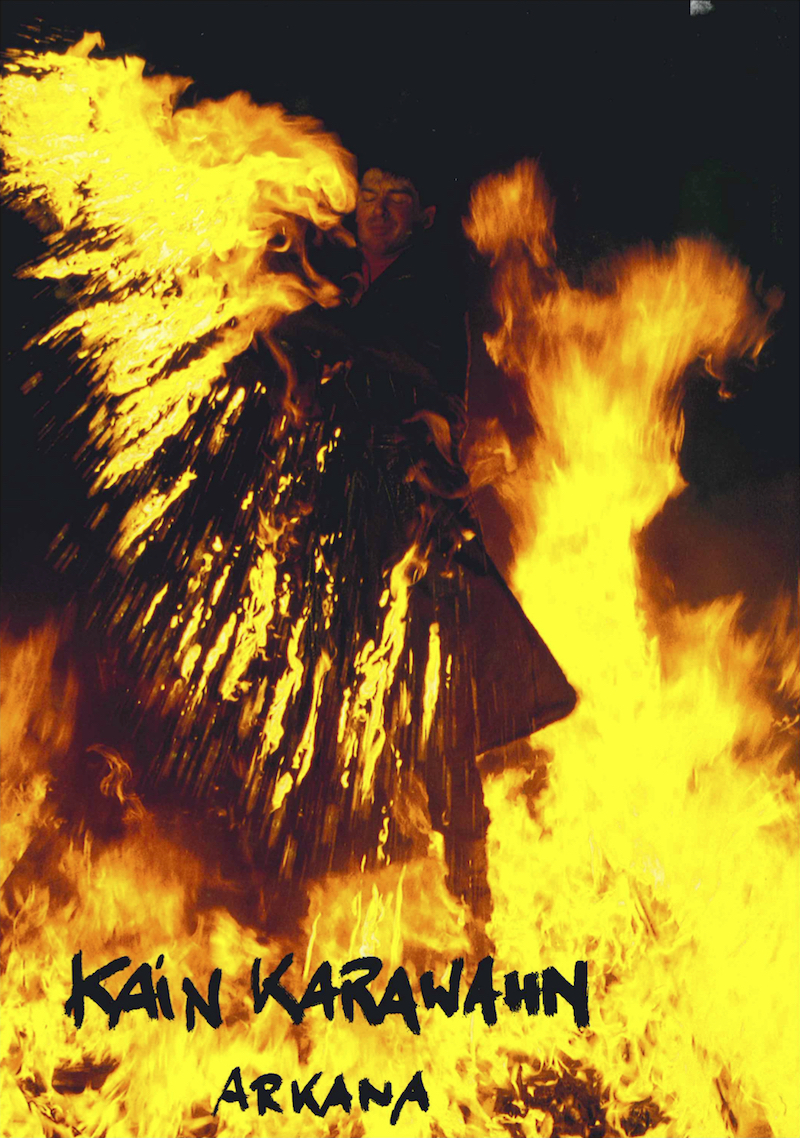
So when you repress curiosity it comes out in other ways, like irresponsible accidents. Can it also turn into pyromania?
Pyromania doesn’t exist. The word was first used at the end of the eighteenth century, in Germany, because there were a lot of arson cases by young girls. At that time, the penalty for arson was death by burning. This was the same time the science of pathology came into focus. Scientists created this pathology of pyromania, which they said was based on pent-up sexual pressure. [Creating a diagnosis] was a way to save these girls so they wouldn’t get punished.
After a couple of years the whole pyromania discussion died down in Germany. But then around 1950, there were two US-Americans who came up with it again. They published a book that became a pyromania bible worldwide, and in it you see references to all these German books from the eighteenth and nineteenth century.
Why did it have a revival?
Because the American education program had stopped teaching people how to burn things. Anyone who even thinks of fire today is sent to a psychological clinic. The other thing is that 200 years ago, industrialization created wealth in normal families. At the start of this [growth of the middle class], rich families were suddenly able to afford separate children’s rooms. Until then, children were in the kitchen and saw how the adults used fire; fire competence was a family tradition. But if you grow up with a separate children’s room, you don’t see how to use fire safely. The first fires in children’s rooms started in the eighteenth century. They wrote children’s books saying not to play with fire, and this has been the rule until today.
They teach you to be afraid.
Young children have an innate fascination with fire—it’s inborn. We are the only beings able to control a campfire. The fireplace used to be the mental, spiritual center of the family. You were responsible for the energy [to heat and light your house] yourself. Now, you have to pay money to get energy that is controlled by big companies. This has a mental effect and consequences. As you can imagine, it’s more interesting for me as an artist to work on socially engaged projects today.
Wasn’t 7,000 Bücherfeuer back in the 1990s already something of a socially engaged project? It was definitely public, provocative, and politicized.
Yes, “books and fire” is a very loaded idea. There’s a long history of burning books, starting with the Bible. There was worldwide [condemnation] when the Nazis did it; but Martin Luther also burned books, and we now celebrate his anniversary. When Blixa and I came up with the idea to burn books, many people said we couldn’t do it—it was forbidden. I said, listen, books are destroyed in our society every day. Who wants to read a book of tax tips from 1988?
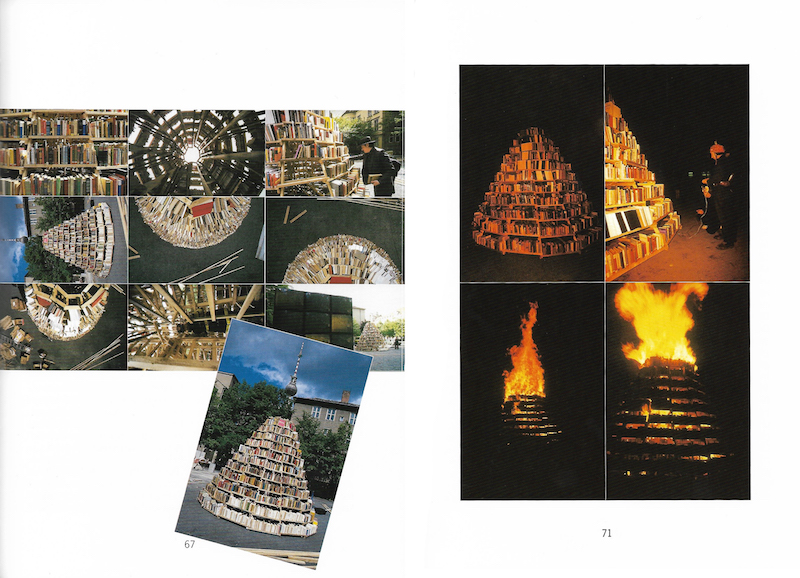
So you chose obsolete books?
We asked people and libraries, even art galleries, to give us books to burn for our project. Books they didn’t want anymore or books that were falling apart. They were happy when we took the books.
Why did you collect 7,000 total?
Because of the cone-shaped construction. I calculated based on how the structure [could support itself], the heat radiation, and so on, and figured out how many books would fit into it.
Did you use gasoline?
Yes. It’s not easy to burn a book. It’s very thick. But I was also careful to find a way to burn them that would leave a lot of ashes.
And those fragments of the burned books from the ashes eventually wound up in the book you made.
With these books that nobody wanted to possess anymore, their information would have been extinguished, deleted forever. So we said, let’s let the fire decide. When you get a book of tax tips from 1988, it doesn’t interest you anymore, but if you get just a little burned piece of a page, that becomes a very valuable relic.
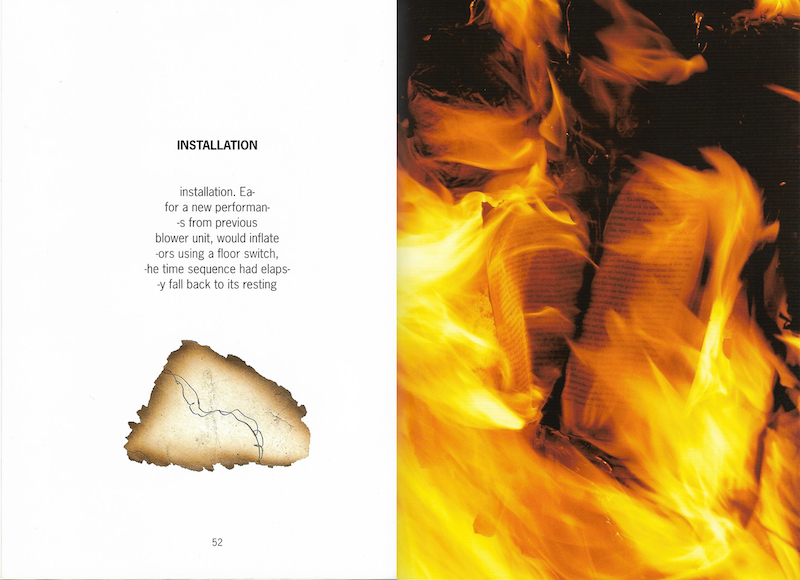
So the leftovers were one form of documentation. What did you focus on with the video and photographic documentation?
With the filming it was important to get moments where the fire opens the book and turns the pages—very spooky. You could read what was written, but the next moment it was gone. After the fire, we started to collect what was left. But there were pieces you could read in the ash but that [disintegrated if] you touched them. So we also had photography and had exhibitions of that.
How did the audience react?
It took about 90 minutes or so for it to burn down. There were some Jewish people there who were calling us Nazis, saying that they would bring us to court. In one TV report, you see them yelling and protesting. We got a very bad review in a Jewish magazine too. They connected our work to the book burning of 1933. I always tried to explain to them that the Nazis selected specific authors; we didn’t make a selection by authors, we made a selection by trash. They were not open to this. To see books on fire is exponentially emotional. To get a clear, rational view, you have to be very strong, and also be a little introduced to the history of books and burning.
But you can’t say that this is only a project that can be understood “rationally”—you were trying to stir up emotions.
Of course. People with a positive fire biography will make two steps forward; people with bad experiences will take ten steps back. That’s normal. Before you judge the use of fire, you have to research the conditions the artist has set up. Every day, books are burned.
Our forefathers treated fire as a spiritual thing. First the hearth, where they cooked, was the altar, it was the holy place where the family gathered. In our society [the spiritual aspect] is forgotten because we don’t need it anymore, but we feel it. In Goethe’s Faust, the first appearance of Mephisto, the devil, comes from a book. Out of the book comes a flame, and the flame becomes Mephisto.

It’s a metaphor for knowledge—the torch of civilization—but it also signifies apocalypse and destruction. To you, it seems to mean constant transformation.
Yes. Later, I started to work with toilet paper. You can only recycle paper five or six times and print on it again—after that, you’re only allowed to make toilet paper out of it. If information can’t get lost, toilet paper is full of information from all the texts that were written on it before. When you burn toilet paper, the movement, the behavior of the burning paper is so poetic it’s unbelievable.
Since 1999 I’ve also done a series of projects on this active volcanic island in Italy, Stromboli. It has 300 eruptions per day. It’s an atmosphere of constant outbreak, but you can still live there. I give seminars there, and I was there in March with a choir. They sang in front of the crater, connecting their voices to the voice of nature. And I do many other projects there. I decided for myself to make work with my hands. But I’m not so interested in spreading it myself. There are people running around [with my teaching model] and making money for themselves, and I’m happy for that.


